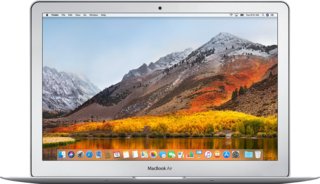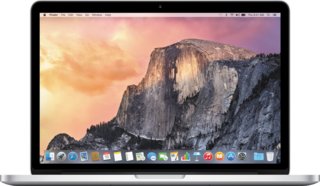Apple MacBook Air (2017) 13.3" Intel Core i5 128GB vs Apple MacBook Pro (2015) 13"
Navigating through the Apple laptop landscape, you'll likely come across the sleek MacBook Air (2017) and the robust MacBook Pro (2015). The MacBook Air, lightweight and perfect for those always on the go, handles everyday tasks like web browsing and word processing with ease. On the other hand, the slightly heavier but sturdier MacBook Pro is a powerhouse, equipped with an advanced processor and superior graphics that handle demanding tasks like programming or video editing smoothly.
Storage-wise, both models have various options to choose from. However, you'll usually find larger capacities with the MacBook Pro. How do you choose between these two? Whether you're a professional in need of a reliable tool or a student looking for a dependable study partner, understanding these comparisons can offer clarity in your decision-making process. It's all about identifying what fits your needs best - portability with sufficient power or robustness with high performance.
System and application performance
Performance in popular 3D games
Viewing angle, color accuracy...
Ports, webcam and other interfaces
Potential battery life
Materials, durability and portability
Design Comparison
Size Comparison
Comparing the Apple MacBook Air (2017) to the Apple MacBook Pro (2015), each laptop presents unique design elements tailored to specific user preferences and requirements. Explore how these design features contribute to the overall user experience, covering aspects like ergonomics, materials, build quality, portability, and special functionalities.
Design Elements Comparison:
Ergonomics:
- Both laptops have a backlit keyboard, making them easier to use in low-light conditions.
- The MacBook Air offers a slightly larger size, allowing for a more comfortable typing experience. The MacBook Pro features an HDMI output to meet the needs of users who need to connect to external displays or projectors.
Materials & Build Quality:
- Both laptops are designed with a sleek and premium aluminum build for durability and a sophisticated appearance.
- The MacBook Pro's VGA connector and Thunderbolt ports broaden connectivity options, catering to professionals with varied peripheral needs.
Portability:
The MacBook Air weighs 3 pounds, making it lighter than the 3.5-pound MacBook Pro, enhancing its portability for students or users often on the move.
- Both laptops are sleek and slim, measuring 0.7 inches in thickness, ensuring portability while maintaining structural strength.
Unique Design Features:
- The MacBook Air lacks Thunderbolt ports but stands out with USB Type-C and Wi-Fi support for modern connectivity needs.
- The MacBook Pro offers excellent connectivity features like Thunderbolt ports and HDMI output, ideal for professionals who need to connect to external monitors or high-speed peripherals.
User Experience Impact:
Students: The lightweight nature of the MacBook Air makes it an ideal companion for students moving between classes or study spaces. Its ample keyboard space enhances comfort during long typing sessions.
Professionals: The additional connectivity options on the MacBook Pro cater to professional needs, allowing seamless integration with external displays and high-performance peripherals. Its robust build quality instills confidence in demanding work environments.
Aesthetic Appeal & Usability:
- Both laptops showcase Apple's minimalist design, but the larger size of the MacBook Air may attract users who value a roomier typing space. The sleek aluminum finish of both models not only adds elegance but also guarantees durability with sturdy construction.
Conclusion:
In summary, the Apple MacBook Air (2017) focuses on portability through its light build and contemporary connectivity choices. Conversely, the Apple MacBook Pro (2015) targets professionals with improved connectivity options such as Thunderbolt ports and HDMI output.
Screen Comparison
| Apple MacBook Air (2017) 13.3" Intel Core i5 128GB | Apple MacBook Pro (2015) 13" | |
|---|---|---|
| Resolution | HD | QHD |
| Screen Size | 13.3" | 13" |
Comparing the screens of the Apple MacBook Air (2017) 13.3" and Apple MacBook Pro (2015) 13" reveals crucial factors that can greatly influence your experience, whether for gaming or professional graphic design work.
Screen Size:
- Both laptops have a 13.3-inch screen, offering a great blend of portability and usability, ideal for diverse tasks while ensuring visibility and comfort.
Resolution: The MacBook Air (2017) provides a resolution of 1440 x 900 pixels, suitable for daily tasks and productivity. However, it may not meet the requirements for intricate graphic design or immersive gaming.
- Conversely, the MacBook Pro (2015) features a higher resolution of 2560 x 1440 pixels, delivering sharper images and finer details, particularly beneficial for visually demanding tasks like video editing or photo manipulation.
Pixel Density: The MacBook Air offers a pixel density of 127 pixels per inch (ppi), suitable for most users. However, professionals working with detailed visuals may find it lacks the desired crispness.
The MacBook Pro boasts a higher pixel density of 227 ppi, ensuring smoother and more defined images and text on the screen. This enhancement elevates the viewing experience for graphic designers and individuals keen on intricate gaming details.
Display Technology:
- The laptops come with IPS (In-Plane Switching) LCD panels featuring LED backlighting. IPS technology offers broad viewing angles and precise color reproduction, making them ideal for tasks such as graphic design or photography editing.
Anti-Reflection Coating: The MacBook Pro (2015) includes an anti-glare coating to minimize reflections and enhance screen visibility in bright environments, making it ideal for outdoor or well-lit work settings.
Supported Displays:
- Both laptops can connect to three external displays, enabling users to extend their workspace for multitasking or immersive gaming with multiple monitors.
Practical Examples: Gaming enthusiasts may find the MacBook Pro's higher resolution and pixel density screen offer a more immersive gaming experience than the MacBook Air.
Graphic designers can benefit from the enhanced clarity provided by the MacBook Pro's high-resolution screen, especially when working on detailed design projects that require precision in representation.
For those who value visual quality in their work or entertainment, the MacBook Pro offers superior resolution and pixel density compared to the MacBook Air. If you focus on general productivity tasks and do not require high visual fidelity, the MacBook Air can still effectively meet your needs.
Hardware Comparison
| Apple MacBook Air (2017) 13.3" Intel Core i5 128GB | Apple MacBook Pro (2015) 13" | |
|---|---|---|
| RAM | 8GB | 8GB |
| Storage Size | 128GB | 1000GB |
Comparing the hardware features of the Apple MacBook Air (2017) 13.3" Intel Core i5 1.8GHz / 8GB / 128GB and the Apple MacBook Pro (2015) 13" allows us to analyze crucial elements like the CPU, GPU, and RAM for a well-informed choice.
Apple MacBook Air (2017) 13.3" with Intel Core i5 processor, 8GB RAM, and 128GB storage capacity:
- CPU: The MacBook Air features an Intel Core i5 processor running at 1.8GHz, delivering reliable performance for daily activities such as web browsing, editing documents, and light multitasking.
- GPU: The built-in graphics processing unit can manage simple multimedia tasks like streaming videos and casual gaming. It may face difficulties with more demanding graphic applications or games.
- RAM: The MacBook Air boasts 8GB of RAM clocked at 1600MHz, enabling seamless handling of numerous browser tabs and light multitasking.
Practical Applications: The MacBook Air is ideal for daily tasks like web browsing, video streaming, document work, and basic photo editing. However, it may not perform as well with resource-intensive software or complex multimedia tasks because of its integrated GPU and limited RAM capacity.
Apple MacBook Pro (2015) 13":
- CPU: The MacBook Pro runs on an Intel Core i5 processor clocked at 2GHz, delivering improved performance over the MacBook Air for demanding tasks.
- GPU: The integrated graphics processor in this model is capable of handling basic multimedia tasks and may perform better with more graphics-intensive applications compared to the MacBook Air.
- RAM: Similar to the MacBook Air, this model features 8GB of RAM operating at a faster speed of 1866MHz.
Practical Applications: The MacBook Pro offers more power than the Air, making it ideal for users who need extra performance for tasks like video editing, programming, or running multiple applications at once. Its faster RAM speed enhances multitasking performance compared to the MacBook Air.
Conclusion: If portability and everyday computing needs such as web browsing and document editing are your main focus, consider the lightweight MacBook Air for decent performance. For tasks like video editing or heavier multitasking that require more power, you might find the MacBook Pro a better fit, even if it means sacrificing some portability for enhanced performance.
Battery Comparison
| Apple MacBook Air (2017) 13.3" Intel Core i5 128GB | Apple MacBook Pro (2015) 13" | |
|---|---|---|
| Battery Life | 12 hours | 12 hours |
Comparing the battery features of the Apple MacBook Air (2017) 13.3" Intel Core i5 1.8GHz / 8GB / 128GB with the Apple MacBook Pro (2015) 13" reveals some important distinctions.
Battery Life:
- Both laptops provide a reliable battery life of up to 12 hours, perfect for users requiring prolonged usage with minimal recharging needs.
Additional Features: The MacBook Air (2017) is equipped with a MagSafe power adapter for easy and secure charging. The MacBook Pro (2015) features Sleep and Charge USB ports that enable charging devices while the laptop is in sleep mode.
- Additionally, the MacBook Pro (2015) comes with a MagSafe power adapter for convenient and effective charging.
Comparison Insights:
- Both laptops come equipped with the MagSafe power adapter for a secure and dependable charging experience. The Sleep and Charge USB ports on the MacBook Pro (2015) offer extra convenience for users who often require charging external devices without waking up the laptop.
Conclusion: Ultimately, the Apple MacBook Air (2017) and the Apple MacBook Pro (2015) both boast impressive battery life lasting up to 12 hours. The MacBook Air comes equipped with a MagSafe power adapter ensuring secure charging, while the MacBook Pro features Sleep and Charge USB ports for enhanced flexibility.
Verdict
Why Apple MacBook Air (2017) 13.3" Intel Core i5 128GB?
- Lightweight and ultra-thin design for enhanced portability.
- Modern USB Type-C and Wi-Fi support for contemporary connectivity needs.
- Longer battery life of up to 12 hours for extended usage without frequent recharging.
Why ?
- The MacBook Pro (2015) offers a more powerful processor and better graphics performance, ideal for demanding applications like video editing or programming.
- It provides larger storage capacity options compared to the MacBook Air (2017), catering to users with higher storage needs.
- The MacBook Pro (2015) features additional connectivity options like Thunderbolt ports and HDMI output, enhancing versatility for professionals with varied peripheral requirements.
Similar comparisons
- Apple MacBook Air (2017) 13.3" Intel Core i5 128GB vs Apple MacBook Air Retina (2018) 13.3" Intel Core i5
- Apple MacBook Air (2017) 13.3" Intel Core i5 128GB vs Apple MacBook Air (2020) 13.3" Apple M1
- Apple MacBook Air (2015) 11" vs Apple MacBook Pro (2015) 13"
- Apple MacBook Air (2015) 13" vs Apple MacBook Pro (2015) 13"
- Apple MacBook Air (2015) 13" vs Apple MacBook Pro (2016) 13"

